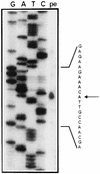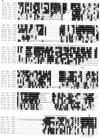Cloning, sequence analysis, and characterization of the genes involved in isoprimeverose metabolism in Lactobacillus pentosus
- PMID: 9573180
- PMCID: PMC107170
- DOI: 10.1128/JB.180.9.2312-2320.1998
Cloning, sequence analysis, and characterization of the genes involved in isoprimeverose metabolism in Lactobacillus pentosus
Abstract
Two genes, xylP and xylQ, from the xylose regulon of Lactobacillus pentosus were cloned and sequenced. Together with the repressor gene of the regulon, xylR, the xylPQ genes form an operon which is inducible by xylose and which is transcribed from a promoter located 145 bp upstream of xylP. A putative xylR binding site (xylO) and a cre-like element, mediating CcpA-dependent catabolite repression, were found in the promoter region. L. pentosus mutants in which both xylP and xylQ (LPE1) or only xylQ (LPE2) was inactivated retained the ability to ferment xylose but were impaired in their ability to ferment isoprimeverose (alpha-D-xylopyranosyl-(1,6)-D-glucopyranose). Disruption of xylQ resulted specifically in the loss of a membrane-associated alpha-xylosidase activity when LPE1 or LPE2 cells were grown on xylose. In the membrane fraction of wild-type bacteria, alpha-xylosidase could catalyze the hydrolysis of isoprimeverose and p-nitrophenyl-alpha-D-xylopyranoside with apparent Km and Vmax values of 0.2 mM and 446 nmol/min/mg of protein, and 1.3 mM and 54 nmol/min/mg of protein, respectively. The enzyme could also hydrolyze the alpha-xylosidic linkage in xyloglucan oligosaccharides, but neither methyl-alpha-D-xylopyranoside nor alpha-glucosides were substrates. Glucose repressed the synthesis of alpha-xylosidase fivefold, and 80% of this repression was released in an L. pentosus delta ccpA mutant. The alpha-xylosidase gene was also expressed in the absence of xylose when xylR was disrupted.
Figures






References
-
- Altschul S F, Gish W, Miller W, Myers E W, Lipman D J. Basic local alignment search tool. J Mol Biol. 1990;215:403–410. - PubMed
-
- Bergmeyer H U. Methods of enzymatic analysis. VI. Deerfield Beach, Fla: VCH Publishers; 1985.
-
- Burland V D, Plunkett III G, Daniels D L, Blattner F R. DNA sequence and analysis of 136 kilobases of the Escherichia coli genome: organisational symmetry around the origin of replication. Genomics. 1993;16:551–561. - PubMed
-
- Callens M, Kerstens-Hilderson H, van Opstal O, de Bruine C K. Catalytic properties of d-xylose isomerase from Streptomyces violaceoruber. Enzyme Microb Technol. 1986;8:696–700.
-
- Daeschel M A, Andersson R E, Fleming H P. Microbial ecology of fermenting plant materials. FEMS Microbiol Rev. 1987;46:357–367.
Publication types
MeSH terms
Substances
Associated data
- Actions
LinkOut - more resources
Full Text Sources
Other Literature Sources
Molecular Biology Databases

